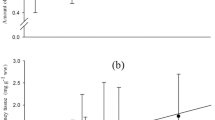Abstract
The FA composition of visceral oil extracted from farmed Atlantic salmon (Salmo salar L.) viscera was studied. Seventeen FA were identified in the extracted visceral oil, and the major FA were 18∶1n9, 16∶0, 16∶1n7, 20∶5n3 (EPA), 14∶0, and 22∶6n3 (DHA). The percentages of saturated, monounsaturated, and polyunsaturated FA in the total FA were 31.7, 36.0, and 32.2%, respectively. Compared with other fish oils, oil from farmed Atlantic salmon had much higher EPA (1.64 g/100 g) and DHA (1.47 g/100 g) contents. The FA profile of the salmon visceral oil was similar to that of the salmon fillet. Thus, the salmon visceral oil could be a replacement for the oil obtained from edible salmon fillet and used in functional foods or feeds requiring a high level of omega-3 FA. Furthermore, producing visceral oil is also beneficial to salmon fish industry by adding value back to the processing waste.
Similar content being viewed by others
References
Horrocks, L.A., and Y.K. Yeo, Health Benefits of Docosahexaenoic Acid (DHA), Pharmacol. Res. 40:211–225 (1999).
Pigott, G.M., and B.W. Tucker, Science Opens New Horizons for Marine Lipids in Human Nutrition, Food Rev. Int. 3:105–138 (1987).
Sun, T., Lipase-Assisted Concentration of n−3 Polyunsaturated Fatty Acids in Acylglycerols from Fish Oils of Atlantic Salmon. M.S. Thesis, University of Washington, Seattle, WA, 2000.
AOCS, Official Methods and Recommended Practices of the AOCS, 5th edn., AOCS Press, Champaign, IL, 1998.
Sun, T., G.M. Pigott, and R.P. Herwig, Lipase-Assisted Concentration of n−3 Polyunsaturated Fatty Acids from Viscera of Farmed Atlantic Salmon (Salmo salar L.), J. Food Sci. 67:130–136 (2002).
Zar, J.H., Biostatistical Analysis, 3rd edn., Prentice Hall, Upper Saddle River, NJ, 1996.
Clarke, K.R., and R.M. Warwick, Change in Marine Communities: An Approach to Statistical Analysis and Interpretation, 2nd edn., Primer-E Ltd., Plymouth Marine Laboratory, Plymouth, United Kingdom, 2001.
Hung, L.B., M.T. Chang, and Y.W. Pan, Supercritical Fluid Extraction of Mackerel Visceral Oil and the Study on Its Edible Safety, Food Sci. 23:641–649 (1996).
Ackman, R.G., Fish Oil Composition, in Objective Methods for Food Evaluation, edited by National Academies of Science, Washington, DC, 1976, pp. 103–131.
Alasalvar, C., K.D.A. Taylor, E. Zubcov, F. Shahidi, and M. Alexis, Differentiation of Cultured and Wild Sea Bass (Dicentrarchus labrax): Total Lipid Content, Fatty Acid and Trace Mineral Composition, Food Chem. 79:145–150 (2002).
Ackerman, R.G., Seafood Lipids, in Seafoods: Chemistry, Processing Technology and Quality, edited by F. Shahidi and J.R. Botta, Kluwer Academic/Plenum, New York, 1995, pp. 35–48.
Hardy, R.W., Conflict Ahead: Can We Reduce Fish Oil Use Aquacul. Mag. 6:44–48 (2003).
Gooch, J.A., M.B. Hale, T. Brown, Jr., C.G. Brand, and L.W. Regier, Proximate and Fatty Acid Composition of 40 Southeastern U.S. Finfish Species, U.S. National Oceanographic and Atmospheric Administration Technical Report, NMFS series, NTIS, Springfield, VA, 1987.
Polvi, S.M., Diet and Availability of Omega-3 Fatty Acids in Salmonids, Master's Thesis, Technical University of Nova Scotia, Halifax, Canada, 1989.
Exler, J., Composition of Foods: Finfish and Shellfish Products: Raw, Processed, Prepared, U.S. Department of Agriculture, Human Nutrition Information Service, Washington, DC, 1987.
Fernandez, C.C., Refinement of Fish Oil for Human Consumption: Engineering Investigations, Ph.D. Thesis, University of Washington, Seattle, WA, 1986.
Wang, Y.J., L.A. Miller, M. Perren, and P.B. Addis, Omega-3 Fatty Acids in Lake Superior Fish, J. Food Sci. 55:71–73 (1990).
Steiner-Asiedu, M., K. Julshamn, and O. Lie, Effect of Local Processing Methods (cooking, frying and smoking) on Three Fish Species from Ghana: Part I. Proximate Composition, Fatty Acids, Minerals, Trace Elements and Vitamins, Food Chem. 40:309–321 (1991).
Karakoltsidis, P.A., A. Zotos, and S.M. Constantinides, Composition of the Commercially Important Mediterranean Finfish, Crustaceans, and Molluscs, J. Food Compos. Anal. 8:258–273 (1995).
Higgs, D.A., and F.M. Dong, Lipids and Fatty Acids, in Encyclopedia of Aquaculture, edited by R.R. Stickney, John Wiley & Sons, New York, 2000, pp. 476–496.
Author information
Authors and Affiliations
Corresponding author
About this article
Cite this article
Sun, T., Xu, Z. & Prinyawiwatkul, W. FA composition of the oil extracted from farmed atlantic salmon (Salmo salar L.) viscera. J Amer Oil Chem Soc 83, 615–619 (2006). https://doi.org/10.1007/s11746-006-1247-2
Received:
Accepted:
Issue Date:
DOI: https://doi.org/10.1007/s11746-006-1247-2




